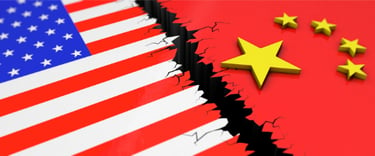The International Trade Blog Import Procedures
The Trade Act of 1974-Part 3: Section 301's Impact Under Trump and Biden
On: February 15, 2021 | By:  Leslie Glick |
4 min. read
Leslie Glick |
4 min. read
 The first and second parts of this series, Section 301 of the Trade Act of 1974: Yesterday, Today and Tomorrow, illustrated how, for many years, Section 301 was used to eliminate trade barriers and open markets to U.S. exports. However, the average business may not have become familiar with this law until President Trump began to invoke it and impose tariffs against China in 2018. The Office of the United States Trade Representative (USTR)—after a notice in the Federal Register and a period for public comment—determined that China violated Section 301 by denying market access to United States companies and infringing on their intellectual property rights. Based on this finding, President Trump imposed the first round of 15% tariffs on $34 billion of Chinese goods covered in what is referred to as List 1.
The first and second parts of this series, Section 301 of the Trade Act of 1974: Yesterday, Today and Tomorrow, illustrated how, for many years, Section 301 was used to eliminate trade barriers and open markets to U.S. exports. However, the average business may not have become familiar with this law until President Trump began to invoke it and impose tariffs against China in 2018. The Office of the United States Trade Representative (USTR)—after a notice in the Federal Register and a period for public comment—determined that China violated Section 301 by denying market access to United States companies and infringing on their intellectual property rights. Based on this finding, President Trump imposed the first round of 15% tariffs on $34 billion of Chinese goods covered in what is referred to as List 1.
After China retaliated with tariffs on U.S. products, the U.S. responded with further 25% tariffs on items from Lists 2 and 3. New products were also added to each list and finally tariffs assessed on a new List 4. A classic trade war had been set in motion.
Fortunately for importers, the Trump administration provided mechanisms for companies to apply for exclusions from these tariffs, based on the unavailability of the imported Chinese product in the United States. Broadly interpreted, this included products not being available in sufficient quantities, within acceptable delivery times and of suitable quality (e.g., meeting a company’s specifications).
For example, some of my automotive industry clients work with low inventories due to a “just in time” delivery practice. They argued that a product was unavailable if it could not arrive in time for them to meet contractual delivery schedules.
Exclusions were granted but could take a long time, particularly in the early stages before the USTR added additional staff. Exclusions were retroactive to the date filed but lasted for only one year. A process was later established to extend exclusions for one more year, but it was not automatic. The same grounds for exclusions had to be proven again.
Unfortunately for importers, all exclusions and extensions ended on Dec. 31, 2020, except for certain products related to COVID-19. This has left many U.S. importers paying high tariffs since the beginning of the year.
A New Phase in the U.S.-China Trade Deal
In January 2020, the Trump administration negotiated what was referred to as a “phase one trade deal” with China. China agreed to escalate purchases of American goods, and each side agreed not to raise existing duties or impose new ones. There were no provisions for rollbacks of existing tariffs. This was reportedly to be left to a phase two, which was expected to occur after the November elections.
Hopes that President Biden would move quickly to remove these China tariffs were unrealized, as the Biden administration announced that the Section 301 tariffs are justified by China’s unacceptable intellectual property practices and that there will be no immediate action to remove them. Organized labor's support for these tariffs was not lost on the Democratic administration that had labor union support in the 2020 election.
Any doubts about President Biden’s inclination to liberalize trade, at least in the short term, were dispelled when one of his early proclamations dealt with strengthening “buy American” procurement practices by the federal government.
Much to the surprise and perhaps the dismay of many in the trade community, at least in the early days of his administration, Biden’s trade policy will be similar to that of the Trump administration.
Other Articles in the Trade Act of 1974 Series
- Part 1: How Section 301 investigations and tariffs impacted trade in its early years.
- Part 2: Special 301 addresses trade barriers due to ineffective protection of intellectual property rights.
Like what you read? Subscribe today to the International Trade Blog to get the latest news and tips for exporters and importers delivered to your inbox.

About the Author: Leslie Glick
Leslie Glick is a shareholder and co-chair of the International Trade and Customs Specialty Team in the Washington, D.C. office of the Michigan-based law firm of Butzel Long P.C. He has practiced in the international trade and customs law area for over 40 years and served as counsel to a Congressional subcommittee.
As an adjunct to his work in these areas he has developed subspecialties in various regulatory areas, particularly Food and Drug Administration regulation of imports and exports of foods, drugs, cosmetics, medical devices, and tobacco and cannabis products. He has also handled issues with the National Highway Transportation Safety Administration (NHTSA) of the Department of Transportation dealing with imports of automobiles and auto parts. Mr. Glick has been a frequent speaker at seminars sponsored by the National Association of Customs Brokers and Forwarders Association of America, Practicing Law Institute, and foreign chambers of commerce such as the CONFINDUSTRIA VICENZA in Italy.
He is a graduate of Cornell University and Cornell Law School and is conversant in Spanish.


